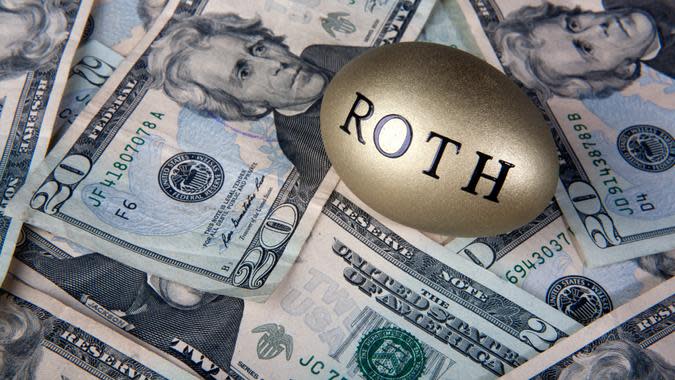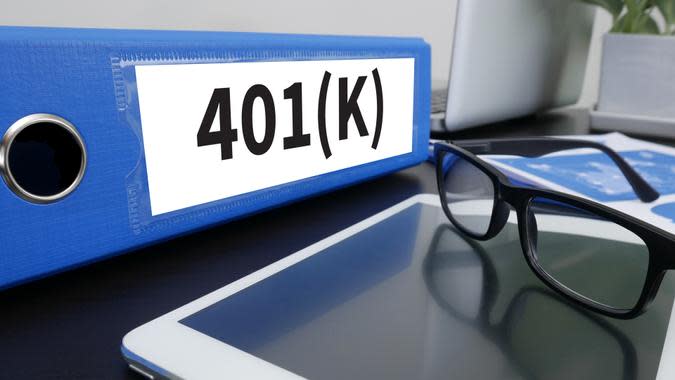11 Worst Retirement Mistakes You Can Make With Your 401(k)

There are many ways to save for retirement, but a 401k plan through your employer is a great way to save for retirement.
Read Next: I’m a Self-Made Millionaire: 5 Stocks You Shouldn’t Sell
Learn More: If You Had Invested $10K in GameStop and AMC in 2021, Here’s How Much You’d Have Today
You not only get tax advantages, but you can also often benefit from employer matching. Plus, when you make contributions through payroll contributions, you can automate your savings and the contribution limits are significantly higher than for individual retirement plans.
There are still pitfalls when using a 401(k), however. Read on to learn 11 things you shouldn’t do with your 401(k) plan, so you don’t jeopardize your retirement savings.

1. Ignore Matching Contributions
If your employer offers to match all or a portion of your contributions to your 401k plan, take advantage of it-this is literally “free money.” That is, money you didn’t have to earn through your income or salary exclusively.
Different employers have different matching schemes. The average amount matched by employers is 4.5%, according to Vanguard’s annual report, however it can vary. Some companies will offer to match only 50% of what you, the employee, contribute. So, say for every $100 you put into your retirement, your company would match $50 — that’s still money that adds up! Other companies may match dollar-for-dollar up to a limit, say $5,000 per year.
If you don’t contribute enough, you’re essentially turning down free money. For example, suppose you make an annual salary of $50,000 and your employer agrees to match half of your 401k contribution up to 6% of your salary. If you only contribute 3% of your salary to the 401k instead of 6%, you’re turning down $1,500 of free money each year.
Discover More: I’m a Financial Advisor: I’d Invest My First $5,000 in These 6 Stocks
Trending Now: 10 Valuable Stocks That Could Be the Next Apple or Amazon

2. Leave a Job Before Employer Contributions Vest
Your employer might attach strings to employer contributions to your 401k plan, known as vesting requirements. Vesting requirements force you to stay with the company for a certain period of time before you have full access to your employer’s contributions. If you leave before the time period expires, your employer keeps any contributions they made to your 401k plan on your behalf.
There are two vesting methods: cliff vesting and graded vesting. With cliff vesting, all employer contributions must be fully vested after you’ve been with the company for a set number of years, typically three. Essentially, it’s a strategy to keep you from taking the money and running, so you’ll have to stick around your job for at least three years.
With graded vesting, employer contributions must vest 20% per year for each year after your first year of employment. Under this method, you are fully vested at the end of six years. Of course, your employer can choose to vest the contributions sooner than required, so it’s important to talk to your employer so you know when your contributions are yours to keep.
Though there might be a few circumstances where it’s worth it to leave any unvested money in your 401k, you should at least be mindful of what you’re giving up when making your decision. Learn what your options are for withdrawing from your 401k.
Check Out: Suze Orman: Parents, Get Roth IRAs for Your Kids So They Can Retire Millionaires

3. Invest Too Much in Company Stock
Many companies offer their own stock as an investment option for their 401k plan participants.
While you don’t have to exclude this option from your 401k plan, you shouldn’t have more than 5 to 10% of your 401k balance invested in your employer’s stock. The percentage should be lower if you have other portions of your net worth tied up in company stock, such as deferred compensation or stock options.
If the company performs poorly, your retirement savings could suffer because you aren’t diversified.

4. Avoiding Investing in Stocks
Just because you should limit your investments in company stock doesn’t mean you should ignore equities altogether in your 401k plan. Though stocks can be scary because they can lose money, super safe investments should also scare you because of the risk of inflation.
For example, you might feel comfortable holding your money in a certificate of deposit because you won’t lose money. But CDs often don’t keep pace with inflation, so you’re actually losing purchasing power.
If you’re not sure how you should be investing in your 401k plan, consider finding a financial advisor to help ensure you stay on the right path to reach your goals.

5. Failing To Change Your Contributions Over Time
When you start a new job, you set your contribution amounts to your 401k plan. Though you can update them anytime, many people stick with a median default contribution rate. But Investopedia says expert recommend a minimum of 10% of your salary as a starting point and working up to as much as 15% over time.
For example, if you start at 3%, you can commit to increasing your contribution percentage by 1% each year without feeling too much of a pinch. Or, you might increase the dollar amount of your contribution by half the amount of your annual raise.
In addition, the 401k contribution limits change over time, which gives you an opportunity to put more money into the plan. For example, in 2024 the annual contribution limit is $23,000 per year.
Discover More: Is It Possible To Purchase Gold and Silver Directly From a Bank?

6. Not Rebalancing Your Portfolio Over Time
Different investments grow at different rates over time, which can lead to your portfolio becoming unaligned with your investing goals.
For example, if the stock market has a few good years, your portfolio could become overweighted in equities, leaving you more exposed than you want to be during a market correction.
You should also look at your investments within each asset class. If one sector has a particularly good or bad year, you might need to readjust. If technology stocks have a great year, for example, you might want to sell some of them and rebalance your portfolio, so you’re not overexposed to that sector having a bad year in the future.
The moral of the story: It’s dangerous to treat your retirement plan as a “set it and forget it” operation.

7. Borrowing Too Much From Your 401k
Some employers let employees borrow money from their 401k plans. If allowed, the maximum loan amount is the smaller of $50,000 or half of your vested account balance. For example, if your balance is $60,000, you can borrow up to $30,000. If your balance is $200,000, you can only borrow up to $50,000. Typically, you have up to five years to repay the loan.
If you leave your job, including if you are let go through no fault of your own, the remaining balance is treated as an immediate distribution, subject to income taxes and early withdrawal penalties. The IRS imposes a 10% early withdrawal penalty on top of the income taxes due. So, if you have a $10,000 balance on your loan that you can’t pay back and you fall in the 25% tax bracket, you’ll owe the IRS $3,500 in taxes and penalties.
That’s not to say that 401k loans are never helpful. When you repay the loan, the interest gets added back to your 401k plan, so you’re essentially paying yourself instead of a bank. As good as that sounds, you’re missing out on the market returns on the money that you’ve borrowed because it’s not invested.

8. Not Comparing Investment Fees
Different 401k plan investments come with different fees. When selecting your investments, compare the fees that you’re paying. Even half a percentage point can make a big difference in the size of your retirement nest egg when you hit retirement age.
According to Employee Fiduciary, you can often find passively managed index funds that charge 0.03 to 2% percent per year.
Check Out: I’m a Banking Expert: Here’s How Much Money You Should Put in a CD

9. Ignoring Roth 401k Options
Some employers offer Roth 401ks as an option in addition to the traditional 401k option. Traditional 401k plans let you put aside pretax dollars that can grow tax-free until retirement. Roth 401k plans offer the opposite: You don’t get to exclude your contributions from your taxable income, but when you take qualified distributions, you don’t pay any taxes.
Roth 401k plans are typically better if you expect to pay higher income taxes in retirement than you pay today. If you want to hedge your bets on what future tax rates will be, you can divide your contributions between both traditional 401k contributions and Roth 401k contributions, though your total contribution limit is still the same.

10. Not Updating Your Beneficiary Designations
While it can be unpleasant to think about, if you die before you empty your 401k plan, the remaining balance will pass to the person that you name on the beneficiary designation form.
You can — and should — update your beneficiary designations over time. If you don’t, your money could be going to someone you don’t want. The beneficiary designation on your 401k plan trumps even your will.
For example, if you originally named a former spouse that you’ve since divorced, your 401k will go to your ex if you didn’t update your 401k plan designation.

11. Roll Your 401(k) Into an Existing IRA
When you leave your job, you can move your money from your old 401k plan to a new qualified retirement plan to avoid taking an early distribution and allowing the money to continue to grow tax-sheltered.
Under the Bankruptcy Abuse Prevention and Consumer Protection Act, funds in your 401k plan are exempt from your creditors, but only the first $1,512,350 of IRA assets are exempt from creditors under federal bankruptcy law.
However, this limit doesn’t apply to money held in an IRA that you rolled over from a 401k plan as long as those funds are held separate from any contributions originally made to an IRA. So, if you have a 401k plan from an old job, do a 401k rollover into a separate IRA to maintain its unlimited creditor protection.
Jordan Rosenfeld contributed to the reporting for this article.
More From GOBankingRates
I'm a Retirement Planning Expert: These 4 States Top Florida and Arizona
7 Things to Do With Your Savings in 2024 to Grow Your Wealth
4 Reasons You Should Be Getting Your Paycheck Early, According to An Expert
This article originally appeared on GOBankingRates.com: 11 Worst Retirement Mistakes You Can Make With Your 401(k)
